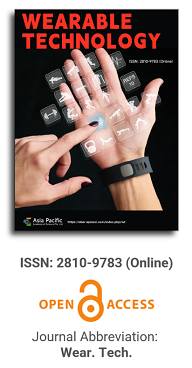

This paper delves deeply into the innovative realm of integrating human emotions with wearable technology. The primary focus is on the conceptualization and development of a kiss transfer device that harnesses the power of wearable technology to bridge the physical gap in human-human interactions. By investigating the intricate nuances of the human-human kissing process, the research seeks to replicate this intimate gesture through a technological medium. The paper not only elaborates on the anatomy, evolution, and hormonal dynamics of kissing but also underscores the transformative potential of wearable technology in capturing and transmitting these intimate moments. This exploration opens up new horizons for long-distance relationships, offering a tangible touchpoint that goes beyond traditional communication methods. Through this pioneering work, the research positions wearable technology as not just a tool for communication but as an extension of our human emotions and expressions.

Research status and progress of intelligent wearable system for first aid based on body area network
Vol 1, Issue 1, 2020
Download PDF
Abstract
With the rise of electronic health services, wireless body area network (WBAN) technology has attracted great international attention. The body area network can obtain human vital sign parameters in its natural state, and support applications in areas such as clinical diagnosis and treatment, emergency rescue and treatment, and health information services. This article introduces the concept of body area network and the electronic medical architecture of body area network, summarizes the advantages of body area network: in low data rate scenarios, the system power consumption of body area network is much lower than that of other wireless communication standards, providing more choices for special frequency bands for medical equipment (500 MHz to 5 GHZ), thereby reducing the interference problem between different communications; proposing bottlenecks and hot spots of body area network: ultra-low power consumption requirements of sensor nodes and hardware resource constraints with limited computing power, and data security protection problems in body area network sensor nodes; the application of body area network in emergency scenarios was analyzed, and the hot spots of body area network research in the field of emergency were summarized and predicted: the development of ultra-low-power chips, wearable wireless nodes, intelligent medical terminals, health and monitoring instruments and other devices and equipment.
Keywords
References
- Han W, Feng G, Hou S. Reflections on the con struction of modern emergency and rescue medicine in the Guangdong–Hong Kong–Macao Greater Bay Area. Chinese Journal of Disaster Rescue Medicine 2020; 8(6): 319–320.
- Tang X, Dong F, Zhang L, et al. Practice and thinking on the construction of medical and health in formation standard system in China. China Journal of Health Information Management 2016; 13(1): 31–36.
- Abidi B, Jilbab A, Mohamed EH. Wireless body area network for health monitoring. J Med Eng Technol 2019; 43(2): 124–132.
- Deng S, Gao W, Hu W, et al. Research status and prospect of wireless body area network technology. Sensors and Microsystems 2014; 33(11): 1–48.
- Wang L, Huang C, Wu X. Research on cross–layer optimization of wireless body area network based on prediction method. Journal of Electronics and Information 2018; 40(8): 2006–2012.
- Cao H, Leung V, Chow C, et al. Enabling technologies for wireless body area networks: A survey and outlook. IEEE Communications Magazine 2009; 47(12): 84–93.
- Chai L, Liu W, Wang Y, et al. Exploration and practice of remote consultation system. Information and Computer 2020; 32(7): 74–76.
- Dong J. Research on health assessment method based on body area network multi–sign information fusion [PhD thesis]. Shaanxi: Xidian University; 2013.
- Liu C. Research and design of wearable intelligent monitoring system [PhD thesis]. Guizhou: Guizhou University; 2018.
- Latha R, Vetrivelan P. Wireless body area network (WBAN)—Based telemedicine for emergency care. Sensors 2020; 20(7): 2153.
- Jin W, Pan W. Design of remote intelligent medical system based on Internet of things technology. Microcomputer Application 2020; 36(5): 113–116.
- Ling L, Chen L, Zhu Y, et al. Tensor flow intelligent medical service platform design. Fujian Computer 2019; 35(6): 95–96.
- Chen J, Zhou Y, Zhou X. Privacy—Preserving telemedicine diagnosis system in wireless body area network. Journal of Changchun Normal University (Natural Science Edition) 2018; 37(5): 37–45.
- Omeni O, Wong ACW, Burdett AJ, et al. Energy efficient medium access protocol for wireless medical body area sensor networks. IEEE Transactions on biomedical circuits and systems 2008; 2(4): 251–259.
- Qu T, Zhao X, Li B. A real-time monitoring system for human health indicators based on wireless body area network (WBAN). Modern Electronic Technology 2013; (18): 128–130, 133.
- Liu Y, Song Y. Research on wireless body area network technology. Small Microcomputer System 2013; 34(8): 1757–1762.
- Wang M, Yang J, Chen H, et al. Research on the development of remote digital health system based on body area network and cloud platform. Computer Science 2012; 039(B06): 195–200.
- Dellarocas C. The digitization of word of mouth: Promise and challenges of online feedback mechanisms. Management Science 2003; 49(10): 1407–1424.
- Sodhro AH, Li Y, Shah MA. Energy–efficient adaptive transmission power control for wireless body area networks. Communications Iet 2016; 10(1): 81–90.
- Abidi B, Jilbab A, Mohamed EH. Wireless body area networks: A comprehensive survey. J Med Eng Technol 2020; 44(3): 97–107.
- Li Y, Cao X. Research on energy—Saving dynamic routing algorithm for body area networks. Software Engineering 2019; 22(11): 15–17.
- Movassaghi S, Abolhasan M, Lipman J, et al. Wireless body area networks: A Survey. IEEE Communications Surveys & Tutorials 2014; 16(3): 1658–1686.
- Peng Y, Zhang S. A power–optimized routing algorithm for wireless body area networks. Electronic Science and Technology 2018; 31(7): 34–37.
- Sun G, Yu J, Li W. Design and implementation of sensor nodes in wireless body area network. Wireless Communication Technology 2011; 20(2): 31–35.
- Wu Z, Sun Y, Tan Y, et al. Three–dimensional graphene–based macro and mesoporous frameworks for high–performance electrochemical capacitive energy storage. Journal of the American Chemical Society 2014; 134(48): 19532.
- Lin W, Lei S, Wei C, et al. Research progress of body area network sensor nodes and wireless communication technology. Journal of Biomedical Engineering 2012; 29(3): 568–573.
- Al-Fares M, Loukissas A, Vahdat A, et al. Commodity data center network architecture. Computer communication review: A quarterly publication of the special Interest group on data communication 2008; 38(4): 63–74.
- Wan J, Zou C, Ullah S, et al. Cloud-enabled wireless body area networks for pervasive healthcare. IEEE Network 2013; 27(5):56–61.
- Zhang Z, Wang H, Vasilakos AV, et al. ECG-Cryptography and authentication in body area networks. IEEE transactions on information technology in biomedicine. Medicine and Biology Society 2012; 16(6): 1070–1078.
- Wu J, Xu H, Wang J. Design of acceleration data compressed sensing for low power consumption in body area network. Chinese Journal of Biomedical Engineering 2015; 34(6): 677–685.
- Peng Y, Tian Y, Peng X. An end-to-end medical wireless body area network lightweight authentica-tion protocol. Computer Engineering 2017; 43(06): 73–77.
- Wang J, Han K, Fan S, et al. A logistic mapping-based encryption scheme for wireless body area networks. Future Generation Computer Systems 2020; 110: 57–67.
- Peng N, Jin Z. Research on energy saving strategy of wireless body area network based on forwarding nodes. Journal of Hangzhou Dianzi University 2011; 31(6): 103–106.
- Gao X, Guo Y, Feng T, et al. Design and implementation of intelligent rehabilitation nursing system based on WBAN. Journal of Sensor Technology 2012; 25(10): 1333–1339.
- Wang M, Yang J, Chen H, et al. Research on the development of remote digital health system based on body area network and cloud platform. Computer Science 2012; 39(101): 195–200.
- Zhang H, Du X, Yang J, et al. Development and testing of a body area network wireless ECG monitoring system. Modern Electronic Technology 2014; (4): 37–41.
- Kasyoka P, Kimwele DM, Angolo SM. Certificateless pairing-free authentication scheme for wireless body area network in healthcare management system. Journal of Medical Engineering & Technology 2020; (4).
- Nino V, Claudio D, Schiel C, et al. Coupling wearable devices and decision theory in the United States emergency department triage process: A narrative review. International Journal of Environmental Research and Public Health 2020; 17(24): 9561.
- Wu A. “On Vivo” and wearable clinical laboratory testing devices for emergency and critical care laboratory testing. The Journal of Applied Laboratory Medicine 2019; 4(2): 254–263.
- Fang X, Luo J. Key technologies and new challenges of body area network. Journal of Internet of Things 2018; 2(1): 64–68.
- Zou W, Kang F, Du G, et al. Design and interference analysis of physical layer scheme based on frequency band of medical body area network in China. Journal of Electronics and Information 2015; (2): 429–434.
- Poon C, Zhang Y, Bao S. A novel biometrics method to secure wireless body area sensor networks for telemedicine and M-health. IEEE Communications Magazine 2006; 44(4): 73–81.
- Han W, Jiang Y, Li J. Comparison of emergency medical service systems in Hong Kong and Mainland China and its enlightenment. Chinese Journal of Hospital Management 2020; 36(12): 1037–1040.
Supporting Agencies
Copyright (c) 2020 Wei Han, Junchao Wang, Yang Zhou, Yingying Jiang

This work is licensed under a Creative Commons Attribution 4.0 International License.

Prof. Zhen Cao
College of Information Science & Electronic Engineering, Zhejiang University
China, China
Processing Speed
-
-
-
- <5 days from submission to initial review decision;
- 62% acceptance rate
-
-
Asia Pacific Academy of Science Pte. Ltd. (APACSCI) specializes in international journal publishing. APACSCI adopts the open access publishing model and provides an important communication bridge for academic groups whose interest fields include engineering, technology, medicine, computer, mathematics, agriculture and forestry, and environment.





